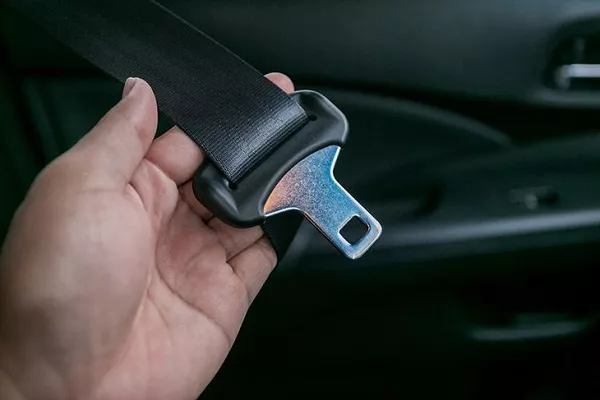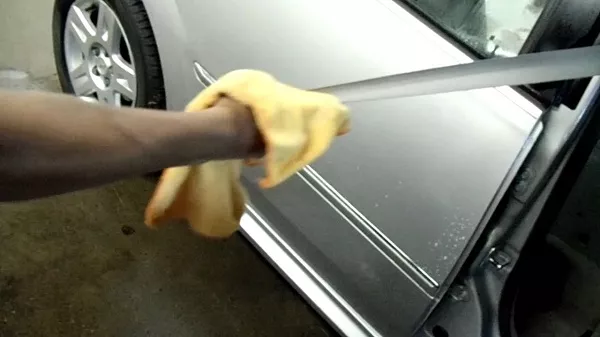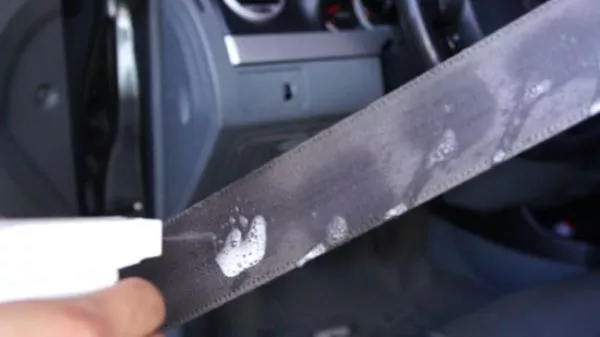We all know the fact that seatbelts are important in keeping the driver and passenger safe in cases of accidents or possible road mishaps. The problem is that when it comes to cleaning, most of us often ignore the seatbelts since they are almost hidden when compared to the seats, dashboard, and the other visible and large parts, making us assume that they don’t get dirty. As a result, you also won’t bother learning how to clean seat belts.
I. Why should you clean your car seat belts?
The reality is that seatbelts are actually exposed to germs, oil, spills, and other dirt without us noticing it. Come to think of it: you are eating your snack in the car and trying to prevent any spills, but when you stop over to pee, you release your seatbelt, unconsciously wiping off whatever is in your finger or hand which came from your food. Similarly, they are also prone to spills as they are near your body.

You constantly hold the seatbelt, exposing it to dirt and germs
Apart from making sure that your seatbelts are free of germs and dirt, here are some of the reasons why cleaning your seatbelts is a must:
- Prevent permanent stain and upholstery damage
- Avoid accumulation of allergens
- Protect seat belts from fades, cracks, and discolorations
- Remove odor
Now that you already know the importance of cleaning seat belts, let’s now proceed with the different processes. Philkotse.com will also include a list of the things you would need so that you no longer have to wonder and ask, “What can I clean seat belts with?”
II. How to clean seat belts
Cleaning seatbelts is not as hard as it may sound, especially since you can choose to either remove the buckle or not. That said, we included the general cleaning method, odor and mold removal method, and the stain-removing method.
1. Basic method
This cleaning technique can be done once every two weeks and would require using the following:
- Metal clamp (can be bought at hardware stores if you do not have one in your toolbox)
- Spray bottle with bleach-free and vinegar-free cleaner or soap solution
- One cup of warm water plus three cups of any of the following: neutral detergent, all-purpose cleaner, baby wash, or dish soap
- Soft-bristled brush
- Microfiber or soft cloth
- Chrome cleaner

Don’t forget the buckles and covers
Here is the best way to clean seat belt straps and buckles:
Step #1: Pull the seatbelt forward up to a point wherein you can no longer pull it. You can pull it out of the door too if you want to.
Step #2: Look for the reel and place a metal clamp right next to it so that the seatbelt won’t retract back.
Step #3: Lightly spray the strap from top to bottom, back to front.
Step #4: Using the brush, gently scrub the belt from top to bottom, making sure that you are not applying too much pressure and using circular motions. Also, do not go back from one area to another.
Step #5: Spray another coat of the cleaner for too dirty seatbelts.
Step #6: Wipe the belt with a towel to remove excess moisture and dirt.
Step #7: Leave it to dry overnight or more. Once dry, unclamp the belt.
Step #8: For steel buckles, all you need to do is polish them with chrome cleaner, while for plastic type, soak it with diluted dishwashing soap solution, gently brush them, and wipe.
>>> Watch this video for more comprehensive instructions:
How To Clean Seat Belts
2. Stain removal
Light and new stains can be removed by the procedure we discussed above. However, for deep-seated and/or old stains, you need to follow the process below and have the following items on hand:
- Cleaning solution (same as above)
- Stiff-bristled brush
- Microfiber or soft towel
- Steam machine and upholstery shampoo or coating (for stubborn stains)
Light and new stains can be removed by the procedure we discussed above
The Steps
- Dip the brush into the solution and tap gently to make sure that there is not much solution in it.
- Look for the stain and start scrubbing gently, from top to bottom. As similar as above, avoid using circular motions or going back to any areas scrubbed.
- You can dip and tap the brush again, and then scrub if the stain is not yet removed.
- If the stain is too stubborn, you can apply upholstery cleaner or coating and then run a steam machine over.
- Wipe the seatbelt with a cloth.
- Let the seatbelt dry.
>>> Suggested posts:
3. Mold and odor removal
Seatbelts are exposed to moisture and changes in temperature and most of the time, they start to get smelly and molds build up. Fortunately, you can do something about it and here are the things you need to prepare:
- Metal clamp (can be bought at hardware stores if you do not have one in your toolbox)
- Bleach-free, soapy solution using 240ml of warm water plus one tablespoon of dish soap and two tablespoons of vinegar.
- Soft-bristled brush
- Microfiber or soft cloth
The Steps
- Pull the seatbelt forward up to a point wherein you can no longer pull it. You can pull it out of the door too if you want to.
- Look for the reel and place a metal clamp right next to it so that the seatbelt won’t retract back.
- Dip the brush into the solution and lightly tap.
- Using the brush, gently scrub the belt from top to bottom, making sure that you are not applying too much pressure and using circular motions. Also, do not go back from one area to another.
- Wipe with cloth to absorb the excess moisture and then gently squeeze the seatbelt.
- Air dry overnight or more.
- Once dry, remove the clamp.

Never forget to wipe the seatbelt before allowing it to air dry
III. Keeping the seatbelts free from odor, stain, dirt, and mold
We hope that this post helped you understand secrets on how to clean your seat belts. Having a clean seatbelt will ensure that you, as the driver, as well as your passengers will have a pleasant ride due to the absence of unwanted molds, dirt, stain, and odor. Cleaning the seatbelts regularly will also add value to your car!
>>> Read more useful tips and advice on car maintenance on Philkotse













